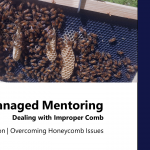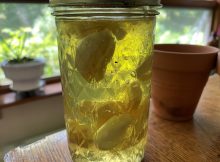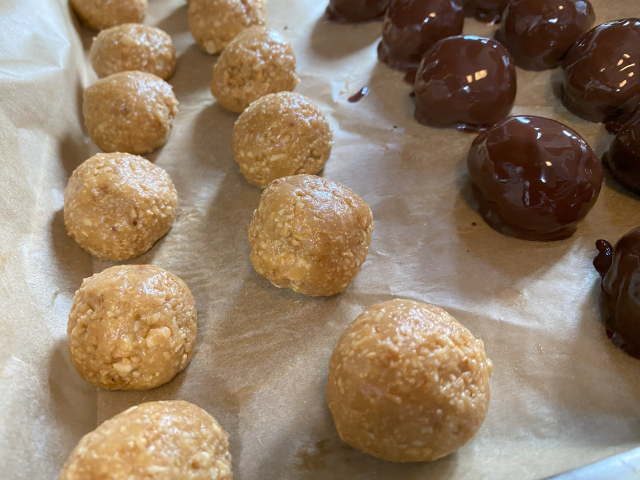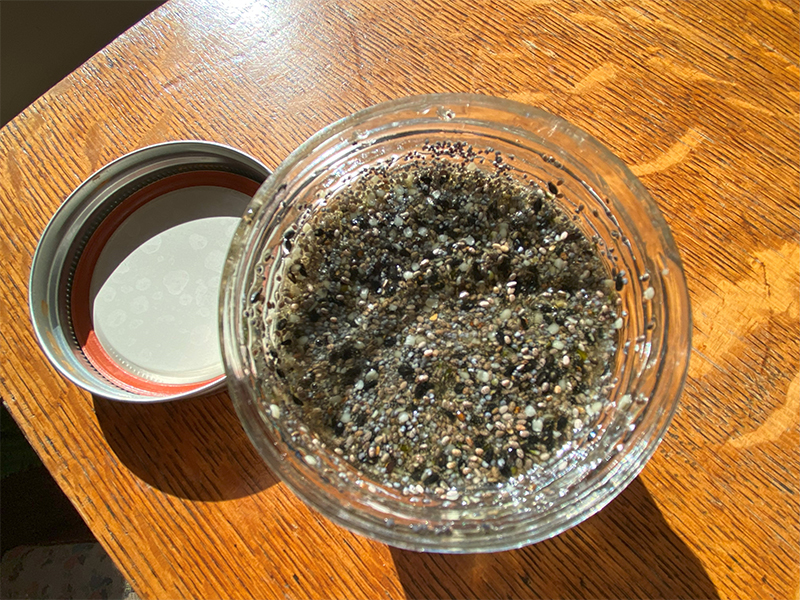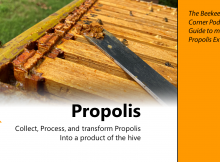It’s Alive
I love the concepts of all things Honey and while harvesting honey this year I started to think through some of the things we might do with this years harvest.
Our son Danny recently introduced us to the Bon Appétit Cooking Channel on YouTube and in it there is a instruction video by chef Brad Leone on how to make Fermented Honey Garlic.
The shtick for Brad’s show is that his presentation is lighthearted and ‘jokey’ which is entertaining but when it comes to recipes I prefer a more food-science style approach (think Good Eats or America’s Test Kitchen). They give you insights about the recipes and why it works.
In his delivery Brad alludes that this fermentation is safe to eat while making lighthearted comments to check the PH and put a splash of vinegar in it as needed.
Ok, I think the real message is common sense, it is safe or they would get sued but still if you make or handle a food product wrong you run the risk of getting sick or even dying of a possible food illness, and in this case specifically botulism.
Now this is not a knock on Brad, in fact I love the show and the content they produce – and I do trust that what he shared was fine (you’ll learn why in a moment) but still I thought it would be interesting to go more into the Alton Brown method of food prep —– and learn why it is safe.
Don’t be surprised! If you listen to the podcast you know that how is usually not good enough for me, I yearn to know why…
Fermented Honey Garlic
Cutting to the chase, this is hardly a recipe. Put some bruised cloves of garlic in fresh honey and pay attention to it while it is fermenting. That’s it. That is really what you are doing. If it is so simple then why is there so much written here about it? Because, in truth there is other relevant information to my way of thinking that need exploring and me being me, I plan to unpack it in a little more detail.
As with anything like this, I am a ‘regular Joe’ and not qualified to give advice on food borne illnesses and risk. My intent here is to share what I learned in my research and as always I would encourage you to do your own due diligence.
So come along on the journey if you wish as I reviewed the botulism aspect, the preparation steps’ do’s and don’ts and some other questions that come up about storage, handling, extensions, appearance nuances, and so on.
Botulism Risk
In Brad’s video he makes a cursory mention about the prospect of botulism. He gave it a “wave of the hand” brush off by saying if you are worried, and you need not be, test it with a PH meter and if it is out of range add a splash of apple cider vinegar. Hmm, for me that requires a little more know how.
Botulism, Food borne botulism, is a harmful bacteria that can thrive and produce toxins in food that can make you ill or at its worse kill you. That last prospect, it can kill you, is in fact very rare. Still given the symptoms – nausea, vomiting, abdominal cramping, dry mouth, shortness of breath and a few other problems that can come your way, well, it is imperative that we give botulism prevention proper consideration. On the more dangerous side, botulism is a neuro-toxin that affects the nerves and paralyzes muscles. In truth, statistics indicate that less than 1000 cases a year are reported in the US^ [Reference #x – ] and to my way of thinking they probably have more to do with improper canning techniques of other products.
For beekeepers in the know, the botulism bacteria could be confusing when you consider that botulism spores are a concern for honey. One of the first things I hope you learned as a beekeeper is there is an inherent risk of giving honey to young children under one year of age due to the presence of botulism spores in honey. Botulism spores exist on plants in nature and presumably are brought back by the bees. It is these spores that infants cannot process – hence the guidance. So when reviewing the concerns of botulism for fermentation, is it to do with the spore aspect or is it something else?
The answer is – Botulism spores are different from food-borne botulism toxins forming during a fermentation. Food borne botulism illnesses result from the ingestion of food containing the aforementioned preformed toxin as a result of botulism growing in the food. Infant botulism is due to the “endogenous production of toxin by germinating spores of C. botulinum in the intestine of the infant.” [Ref. #1 – CDC Link] The definition of endogenous relates to something happening internally – and in this case it is production inside of an infant.
Kevin Moment: Now I would suppose that you still should not give fermented honey garlic to infants under one – but how many of them want to gnaw on a honey soaked garlic morsel? I digress.
End of Kevin Moment
Suitability
Of the many things you could pickle or ferment, Honey Fermented Garlic – happens to have several factors that aid in the prevention of botulism forming.
Conditions for Botulism
Botulism would thrive in the following conditions (Refer to Reference #1):
- Fermentation in high ambient temperatures
- Fermentation in an environment deficient of oxygen
- Fermentation in a low acid environment
- Defined as when the PH level of the mixture is allowed to exceed a reading of 4.6
- Fermentation in a low salt mixture
- Fermentation that supplies a protein source
- and Fermentation that is done in a low sugar environment.
The good news for us is the inherent nature of the product we are making and the handling instructions take care of these items in this way:
- We will store the product in a cool dark place (or in the refrigerator).
- There is oxygen available to the fermentation
- Honey is acidic by nature
- There is no salt involved, nor is there protein (as might be more common in canning or canned goods)
- Honey is of course a high sugar environment so there are plenty of microbes for the fermentation to feed on (good microbes)
The key thing we have going for us is raw honey is both acidic and it provides a high sugar environments. The average PH of honey is 3.9 and that is well below the acidity danger zone of 4.6
The Role of Acidity
The acidity of honey ranges from a pH of about 3.4 to about 6.1, with an average of 3.9. The acidity of any honey is directly related to the floral sources that created it. Even better news is that after fermentation begins, it becomes even more acidic, which equates to a low PH and that is just what we are looking for.
Net net, for these reasons it is generally considered safe. However if this did not convince you, and I would always encourage you to ‘trust but verify’, test your fermentation.
Simply take a PH reading to ensure that the PH is not above 4.6. Alternatively, if you have no way to test, one thing you can do is control your destiny by physically making it more acidic through the addition of a a splash of cider vinegar.
Temperature / Storage
Almost everyone who posts about this on the internet suggests that you store this at room temperature and that it does not have to be refrigerated.
There is a recommendation to refrigerate chopped garlic in oil from the CDC but that is a different food altogether. Fermentation results in lactic acid which makes this fermentation safe. This mixture will continue to ferment for a long period but not forever. Contrasting that to garlic in oil, that is not acidic and hence it requires refrigeration and consumption by the expiration date.
Still, if you want to be ultra conservative, go ahead, put it in the fridge. I have read that some who are still paranoid will let it ferment for 30 days on the counter and then after the main ferment has slowed down they will store it in the refrigerator.
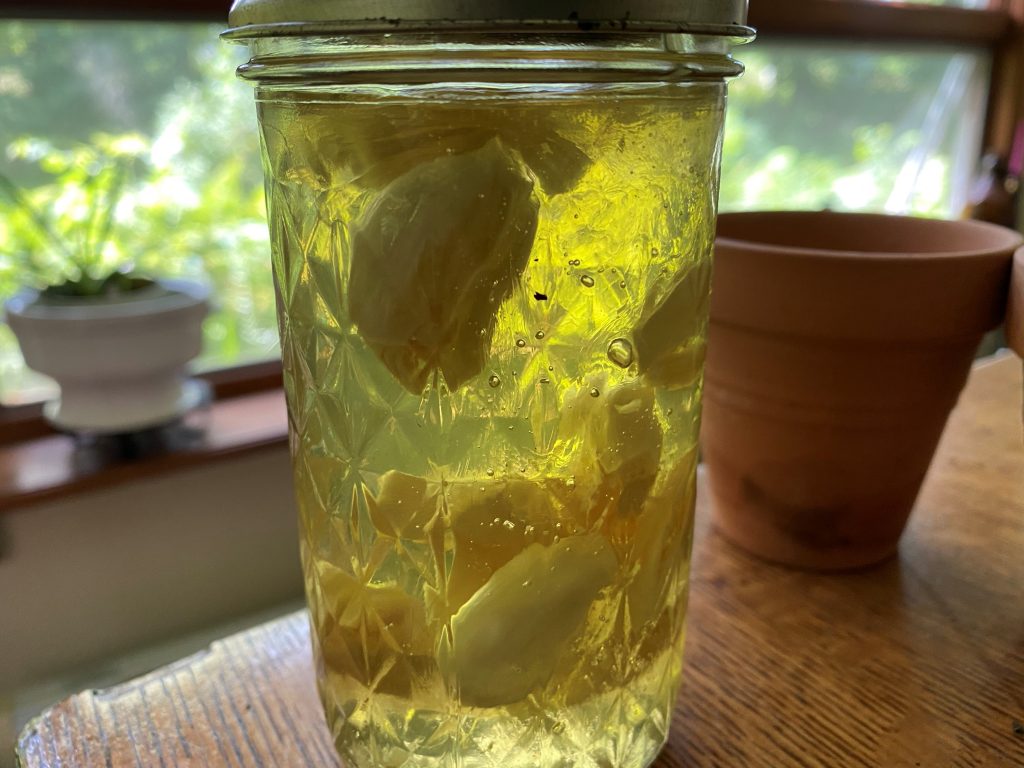
Other Odds and Ends
During the course of looking deeper several other points surfaced that will be of interest. They have to do with appearance over time, tips and tricks for success, and how long does this stuff really last.
Appearance
Appearance wise when you look at the photos of various fermentation’s online they all look so appealing. A golden elixir with little candied garlic pearls floating. In reality the garlic may turn out decidedly different.
This one is a bit squeamish but sometimes the garlic gets funky and you need to embrace it. It is perfectly normal for the garlic to turn blue greenish or dark. This is not the garlic going bad.
The fact is there is a chemical reaction in fermenting garlic that often causes it to change appearance. It might seem odd to consume blue green garlic but it does not affect flavor and is totally safe to eat. I am not sure if it is synonymous but we do eat blue cheese right?
Use the Right Ingredients
In this global economy our food comes from all corners of the world. It is not unusual to see produce in big chain stores, like garlic for example, that comes from China or other locations. If you think of this from a fermentation aspect, fermentation works best with fresh ingredients. Using garlic that probably was grown last summer (that is possible because with the right storage, and given the fact that it is pretty durable, it could be provisioned that way) is not the right way to go.
Make a concerted effort to use garlic that is grown locally and fresh – it will result in the best outcome.
The same can be said about honey. Sadly, much of the world’s honey is suspect for being adulterated or at best super processed through heat and filtration. Fresh Raw Honey is the only way to go. It can be sourced from a beekeeper or many local farmers markets. Look at the location origin on the label.
Crystallization
One more thing about honey – sometimes it crystallizes and this is completely normal. If you find yourself with a jar of honey that has crystallized, it is not bad, it has simply changed state. If your honey is crystallized, simply warm the contents of the jar by submerging it a hot water bath to melt the crystals. Liquefied honey is the way to go for this recipe.
Mix-In Ingredients
As it is with home canning and fermentation, some wish to be creative. Could you mix in other things and go beyond just honey and garlic? The short answer is yes, but you need to be careful. A pretty common mix-in, and a reasonable flavor combination to go with garlic, is adding fresh ginger root. It is apparently okay to do this and you will see several variations of ginger-garlic-honey recipes out there. However, and this is important, this does not mean you can randomly mix in any kind of ingredient.
For example, cinnamon might be considered a pretty good pairing but there are specific warnings not to use cinnamon in this fermentation because something in the cinnamon inhibits the fermentation and adds risk for botulism.
My guidance on this is you are good to go with honey and garlic. All signs appear to indicate that Ginger is acceptable, but even with Ginger or any other ingredients I would do some research and only use recipes from a reputable source.
How Long will it last?
And you might ask yourself – where is my large automobile. And you might ask yourself – how did I get here. LOL. Sorry, I could not resist. Letting the days go by, let the water hold me down.
That is a reference to the Talking heads song ‘Once in a Life Time’ from 1984, the year I graduated high school.
What I meant to say is, you might ask yourself how long does this fermentation take and what is the shelf life of the product?
Normal guidance is the active fermentation lasts a month. Once it settles down it appears that passive fermentation, resulting in the creation of the protective acids that go on for up to a year. While the taste gets better with age, I would suggest consumption by 6 to 8 months to be safe and most sites say the shelf life is no longer than a year. I am not sure if we will brave enough to test any of these limits and presuming it is super tasty we have long since consumed our elixir by the time any of these periods are approaching.
One thing is clear, if you are holding this for longer time frames (think months old) it would be wise to procure some PH test strips or some form of tester and test it periodically just to make sure it is in the safe PH zone (Under 4.6).
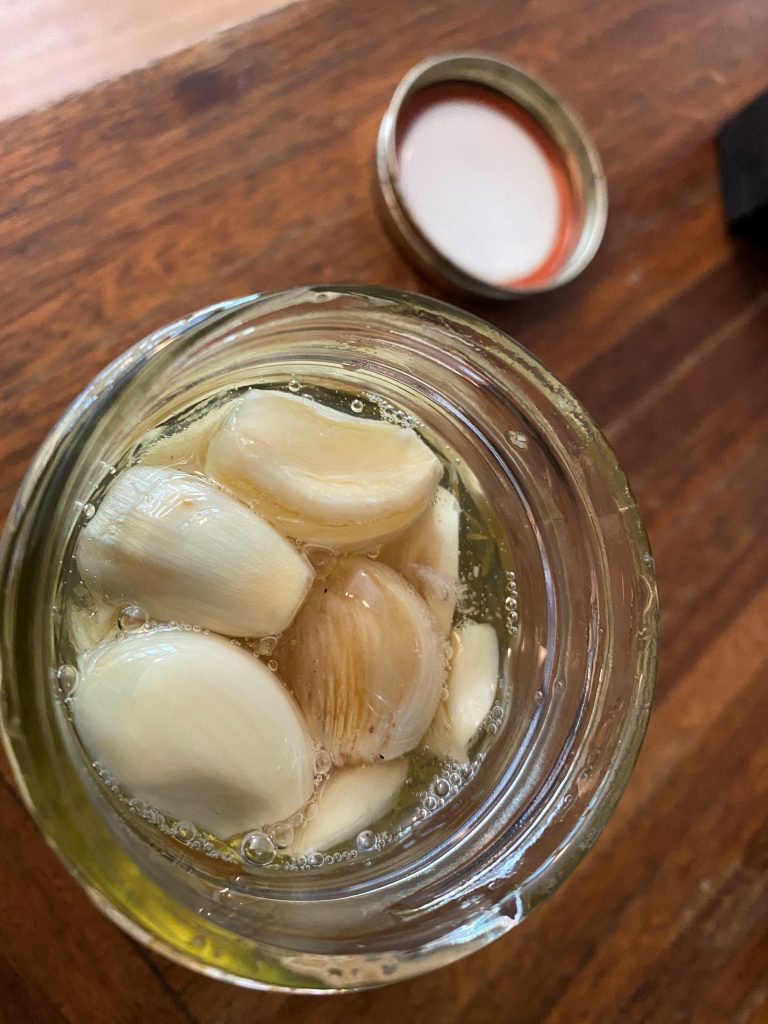
The Recipe
We just harvested honey this past weekend and used the honey filtered from the cappings as it was just about the right amount.
Ingredients:
- 12 garlic cloves (about 1 head), crushed
- 1½ cups raw honey
Equipment
1 quart Jar
Instructions
- For assembly you will want at 2 cup jar, preferably with a canning jar lid.
- Peel the garlic cloves and bruise them slightly by giving them a sharp wrap with the side of a chef’s knife. No need to cut them up or mince them – whole, but bruised is what you want.
- When prepping the garlic trim off the ends and cut out any dark spots and/or blemishes.
- Add the garlic to your jar and pour in the liquid honey.
- The honey should envelope the garlic and you can turn it over or mix it in to assure that all of the garlic is coated.
- Make sure you leave some ‘head space’ in the jar – do not fill it to the top. The head space, or air gap at the top, allows for gasses to collect. Forget this step and you will have a volcano style event in your future.
- Seal the jar, put a label on it with the date it was made, and let sit at room temperature 3 days.
Care Tips
- In three days, unscrew and remove lid to let out any gases;
- At this point you might want to see if you have signs of fermentation through the appearance of any tiny bubbles which is an indicator that the fermentation process has started.
- Swirl the honey in the jar and/or turn it over and then set it in a conspicuous place so you can gently turn your jar over every few days, or whenever you think about it.
- Keep your jar stored in a cool dark place and in time you will see that the honey changes viscosity.
- It will become runny and note that it is likely the garlic will likely turn a few shades darker and so will the liquid. In addition it is customary for light honey to darken to an amber hue.
- Keep tabs on it for 30 days, checking the need to burp it during the active fermentation period of 30 days or more
- By the way, if you forget to burp it, it will build up pressure and you’ll come home to a big mess one day – you have been warned.
- Periodically turn it over and keep any separations mixed in.
- During the ferment the liquid in the jar will thin out. Part of the transformation during fermentation will be moisture coming out of the garlic. The exuded water may float to the surface and it is important to watch your ferment and to stir it occasionally to keep the moisture cohesive.
Consider an Airlock
There are two things the forgetful fermenter can purchase for fermenting:
Silicone Airlock and Weights
- The first is a silicone airlock waterless fermentation lid, often called a pickle pipe in fermenting circles. This silicone cap has a little nipple on the top of a flat lid with a small hole. When pressure builds up it pushes out on the hole and that causes the hole to open and allows the gas to escape. No need to burp the jar. When the gas pressure is down the silicone takes its normal closed shape – resulting in gas escape but no air or oxygen getting in.
- Another thing that is often sold for fermenting kits is a fermentation weight. These weights go in the jar, under the lid, and serve the purpose to weight down any floating food so they do not float into the open space. They keep the fermenting food – usually vegetables, submerged.
So fermented Honey Garlic. We have some upstairs churning away and if I think of it I will come back to tell you how it turned out.
I verbally relayed the recipe I documented but I would implore you to visit the Bon Appétit website in the show notes for the formal recipe. There you can read an experts presentation of a recipe, and any of the comments of people who have followed their instructions.
External Links
Bon Appétit Recipe:
https://www.bonappetit.com/recipe/fermented-garlic-honey
Bon Appétit YouTube Feature – It’s Alive:
https://youtu.be/XLVxVQ8O0s4
Ref. #1 CDC National Botulism Surveillance – https://www.cdc.gov/botulism/surveillance.html
Ref #2 – Colorado State University Botulism Fact Sheet:
Conditions that favor botulism include a high-moisture, low-salt, low-acid environment in which food is stored without oxygen or refrigeration. Address:
https://extension.colostate.edu/topic-areas/nutrition-food-safety-health/botulism-9-305/
Accessed: 5/17/2020.
Other References:
CDC Botulism in the United States Handbook – https://www.cdc.gov/botulism/pdf/bot-manual.pdf
Mayoclinic.org – Heading – Prepare and store foods safely: https://www.mayoclinic.org/diseases-conditions/botulism/symptoms-causes/syc-20370262
Image Credits: The photos in this post are mine



